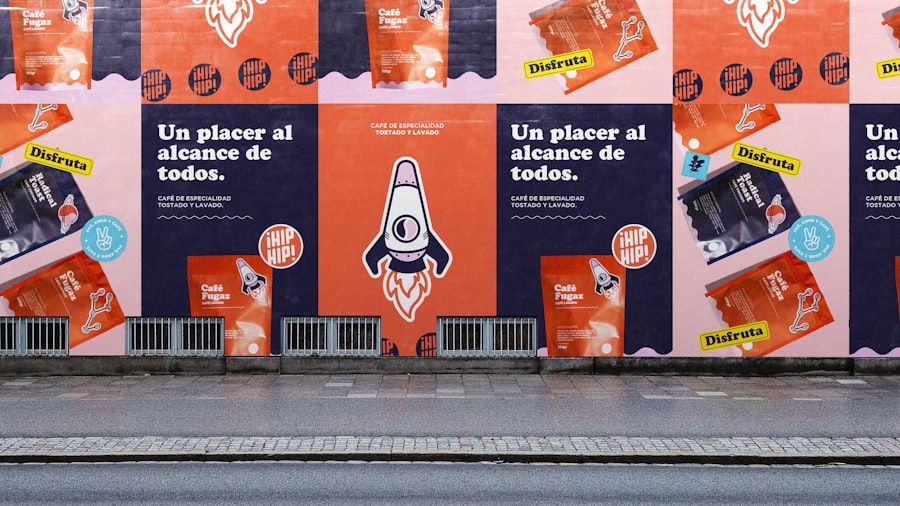Football, often referred to as the beautiful game, transcends mere sport; it is a global phenomenon that unites millions of fans across diverse cultures and backgrounds. The power of football advertising lies in its ability to tap into this vast audience, creating a unique platform for brands to connect with consumers on an emotional level. The sheer scale of viewership during major tournaments, such as the FIFA World Cup or UEFA Champions League, presents an unparalleled opportunity for advertisers.
For instance, the 2018 FIFA World Cup attracted over 3.5 billion viewers worldwide, making it one of the most-watched events in history. This immense reach allows brands to showcase their products and services to a captive audience, often leading to significant increases in brand awareness and sales. Moreover, football advertising is not just about numbers; it’s about the deep-rooted passion that fans have for their teams and the sport itself.
This passion creates a fertile ground for brands to cultivate loyalty and engagement. When a brand aligns itself with a football club or a player, it can evoke strong emotional responses from fans, leading to a sense of belonging and community. For example, brands like Nike and Adidas have successfully leveraged their partnerships with top clubs and players to create campaigns that resonate deeply with fans.
By associating their products with the triumphs and struggles of beloved teams and athletes, these brands have managed to create lasting impressions that go beyond traditional advertising.
Key Takeaways
- Football advertising harnesses the sport’s massive global appeal to engage diverse audiences.
- Crafting a winning campaign requires strategic planning aligned with football fans’ interests and behaviors.
- Leveraging fan passion and emotions creates deeper connections and brand loyalty.
- Integrating social media and influencers amplifies reach and engagement in football campaigns.
- Measuring campaign success through clear metrics ensures continuous improvement and impact.
Creating a Winning Campaign Strategy
Developing a successful football advertising campaign requires a well-thought-out strategy that aligns with both the brand’s objectives and the unique characteristics of the sport. The first step in crafting this strategy is to identify the target audience. Understanding who the fans are—demographics, interests, and behaviors—enables brands to tailor their messaging effectively.
For instance, a campaign aimed at younger audiences might focus on social media engagement and influencer partnerships, while a campaign targeting older fans might leverage traditional media channels like television and print. Once the target audience is defined, the next step is to establish clear objectives for the campaign. These objectives could range from increasing brand awareness to driving sales or enhancing customer loyalty.
A well-defined goal provides a roadmap for the campaign and helps in measuring its success later on. Additionally, brands should consider the timing of their campaigns in relation to key football events. Launching a campaign during a major tournament or when a team is performing well can significantly amplify its impact.
For example, brands that released ads during the 2020 UEFA European Championship saw heightened engagement due to the tournament’s popularity and the excitement surrounding it.
Leveraging the Passion of Football Fans

The fervor that football ignites among its fans is unparalleled, making it an ideal avenue for brands to engage with consumers on a deeper level. Football fans are not just passive viewers; they are active participants in the culture surrounding the sport. This engagement can be harnessed through various strategies that resonate with their passion.
One effective approach is to create content that celebrates the sport’s history, iconic moments, or legendary players. By tapping into nostalgia, brands can evoke strong emotional responses that foster loyalty. Another way to leverage this passion is through interactive campaigns that encourage fan participation.
For instance, brands can create contests or challenges that invite fans to share their own football experiences or showcase their skills. This not only increases engagement but also builds a sense of community among fans. A notable example is Coca-Cola’s “Share a Coke” campaign during the 2014 FIFA World Cup, where fans were encouraged to find bottles with their names or their favorite players’ names on them.
This campaign not only generated excitement but also created a personal connection between the brand and its consumers.
Key Elements of Successful Football Advertising
| Key Element | Description | Example Metric | Importance Level |
|---|---|---|---|
| Target Audience Understanding | Identifying and analyzing the demographics and interests of football fans. | Audience Reach (%) | High |
| Emotional Engagement | Creating ads that connect emotionally with viewers, leveraging passion for football. | Engagement Rate (%) | High |
| Brand Integration | Seamlessly incorporating the brand into football-related content. | Brand Recall (%) | Medium |
| Timing and Placement | Choosing optimal times and platforms for ad delivery during football events. | Ad Viewability Rate (%) | High |
| Creative Storytelling | Using compelling narratives that resonate with football culture and values. | Ad Completion Rate (%) | Medium |
| Use of Influencers and Athletes | Featuring popular football players or influencers to boost credibility and appeal. | Influencer Engagement Rate (%) | Medium |
| Call to Action (CTA) | Clear and motivating prompts encouraging viewers to take desired actions. | Conversion Rate (%) | High |
| Multi-Channel Approach | Utilizing various platforms such as TV, social media, and mobile apps for wider reach. | Cross-Platform Reach (%) | High |
Successful football advertising campaigns share several key elements that contribute to their effectiveness. First and foremost is authenticity; brands must ensure that their messaging aligns with the values and culture of football. Fans are quick to spot insincerity, and any perceived disconnect can lead to backlash.
For example, when brands attempt to capitalize on football culture without genuine involvement or understanding, they risk alienating their target audience. Another critical element is creativity. In an environment saturated with advertisements, standing out requires innovative ideas that capture attention and spark interest.
This could involve using humor, storytelling, or even unexpected collaborations with players or clubs. A prime example of creativity in football advertising is Nike’s “Write the Future” campaign from 2010, which featured a star-studded cast of players and showcased how individual moments in football can change lives and careers. The ad was not only visually stunning but also resonated deeply with fans’ aspirations and dreams related to the sport.
Utilizing Social Media and Influencers
In today’s digital age, social media has become an indispensable tool for football advertising. Platforms like Instagram, Twitter, and TikTok allow brands to reach audiences directly and engage with them in real-time. The immediacy of social media enables brands to capitalize on trending topics or viral moments related to football, creating opportunities for timely and relevant content.
For instance, during major tournaments, brands can create live content that captures the excitement of matches or fan reactions, fostering a sense of community among followers. Influencer marketing also plays a significant role in football advertising strategies. Collaborating with popular football players or social media influencers can amplify a brand’s message and reach new audiences.
Influencers have established trust with their followers, making their endorsements more impactful than traditional advertising methods. Brands like Puma have successfully partnered with players such as Neymar Jr., leveraging his massive following to promote their products authentically. By showcasing products in relatable contexts—such as training sessions or match days—brands can create compelling narratives that resonate with fans.
Tapping into the Emotions of Football

Football is an emotional sport; it evokes joy, heartbreak, pride, and camaraderie among fans. Successful advertising campaigns tap into these emotions to create powerful connections with consumers. Brands can evoke feelings of nostalgia by referencing iconic moments in football history or celebrating legendary players who have left an indelible mark on the sport.
For example, Adidas’ “Impossible is Nothing” campaign featured stories of athletes overcoming adversity, resonating deeply with fans who see parallels in their own lives. Additionally, leveraging the communal aspect of football can enhance emotional engagement. Fans often come together to support their teams during matches, creating shared experiences that brands can tap into.
Campaigns that celebrate these moments—such as watching games with friends or family—can foster a sense of belonging among consumers. A notable example is Budweiser’s “Wassup” campaign during the 2000s, which became synonymous with camaraderie among friends watching football together. By aligning their messaging with these shared experiences, brands can create lasting emotional connections with their audience.
Measuring the Success of Your Campaign
Measuring the success of a football advertising campaign is crucial for understanding its impact and informing future strategies. Key performance indicators (KPIs) should be established at the outset based on the campaign’s objectives. Common KPIs include brand awareness metrics such as reach and impressions, engagement rates on social media platforms, website traffic generated from campaign-related content, and ultimately sales figures.
Tools such as Google Analytics can provide insights into how users interact with campaign-related content online, while social media analytics tools can track engagement metrics like likes, shares, comments, and follower growth. Additionally, conducting surveys or focus groups can provide qualitative insights into consumer perceptions of the campaign and its effectiveness in resonating with the target audience. By analyzing this data comprehensively, brands can assess what worked well and what could be improved in future campaigns.
Case Studies of Successful Football Advertising Campaigns
Several case studies exemplify successful football advertising campaigns that effectively harnessed the power of the sport to achieve remarkable results. One standout example is Nike’s “The Last Game” campaign during the 2014 FIFA World Cup. The animated short film featured top players like Cristiano Ronaldo and Neymar Jr., portraying a fictional narrative where they faced off against clones who played without passion or creativity.
The campaign resonated deeply with fans by emphasizing the importance of individuality and creativity in football while promoting Nike’s products seamlessly within the storyline. Another notable case is Heineken’s “The Perfect Match” campaign during UEFA Champions League matches. The brand created engaging content that highlighted the excitement of match days while encouraging fans to enjoy Heineken responsibly.
By integrating user-generated content into their strategy—inviting fans to share their match day experiences—Heineken fostered community engagement while reinforcing its brand message. These case studies illustrate how effective storytelling, emotional resonance, and strategic alignment with football culture can lead to successful advertising campaigns that not only capture attention but also foster lasting connections between brands and consumers in the world of football.



